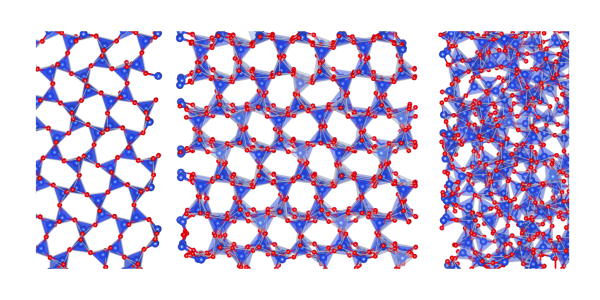Hybrid crystal-glass materials from meteorites transform heat control
Adapted from the Columbia Engineering release - text by Ellen Neff
Crystals and glasses have opposite heat-conduction properties, which play a pivotal role in a variety of technologies. These range from the miniaturization and efficiency of electronic devices to waste-heat recovery systems, as well as the lifespan of thermal shields for aerospace applications.
The problem of optimizing the performance and durability of materials used in these different applications essentially boils down to fundamentally understanding how their chemical composition and atomic structure (e.g., crystalline, glassy, nanostructured) determine their capability to conduct heat. A study published in the Proceedings of the National Academy of Sciences, involving former and current MARVEL members, tackles this problem from first principles — i.e., in Aristotle’s words, in terms of “the first basis from which a thing is known” — starting from the fundamental equations of quantum mechanics and leveraging machine-learning techniques to solve them with quantitative accuracy.
Michele Simoncelli, previously in MARVEL and now at the University of Columbia, MARVEL director Nicola Marzari and Francesco Mauri from Sapienza University of Rome predicted the existence of a material with hybrid crystal-glass thermal properties, and a team of experimentalists led by Etienne Balan, Daniele Fournier, and Massimiliano Marangolo confirmed it with measurements. The first of its kind, this material was discovered in meteorites and has also been identified on Mars. The fundamental physics driving this behavior could advance our understanding and design of materials that manage heat under extreme temperature differences—and, more broadly, provide insight into the thermal history of planets.

Thermal conduction depends on whether a material is crystalline, with an ordered lattice of atoms, or glassy, with a disordered, amorphous structure, which influences how heat flows at the quantum level–broadly speaking, thermal conduction in crystals typically decreases with increasing temperature, while in glasses it increases upon heating.
In 2019, Simoncelli, Nicola Marzari, and Francesco Mauri derived a single equation that captures the opposite thermal-conductivity trends observed in crystals and glasses—and, most importantly, also describes the intermediate behavior of defective or partially disordered materials, such as those used in thermoelectrics for waste-heat recovery, perovskite solar cells, and thermal barrier coatings for heat shields.
Using this equation, they investigated the relationship between atomic structure and thermal conductivity in materials made from silicon dioxide, one of the main components of sand. They predicted that a particular “tridymite” form of silicon dioxide, described in the 1960s as typical of meteorites, would exhibit the hallmarks of a hybrid crystal-glass material with a thermal conductivity that remains unchanged with temperature. This unusual thermal-transport behavior bears analogies with the invar effect in thermal expansion, for which the Nobel Prize in Physics was awarded in 1920.
That led the team to the experimental groups of Etienne Balan, Daniele Fournier, and Massimiliano Marangolo in France, who obtained special permission from the National Museum of Natural History in Paris to perform experiments on a sample of silica tridymite carved from a meteorite that landed in Steinbach, Germany, in 1724. Their experiments confirmed their predictions: meteoric tridymite has an atomic structure that falls between an orderly crystal and disordered glass, and its thermal conductivity remains essentially constant over the experimentally accessible temperature range of 80 K to 380 K.
Upon further investigation, the team also predicted that this material could form from decade-long thermal aging in refractory bricks used in furnaces for steel production. Steel is one of the most essential materials in modern society, but producing it is carbon-intensive: just 1 kg of steel emits approximately 1.3 kg of carbon dioxide, with the nearly 1 billion tons produced each year accounting for about 7% of carbon emissions in the US. Materials derived from tridymite could be used to more efficiently control the intense heat involved in steel production, helping to reduce the steel industry’s carbon footprint.
In this PNAS article, Simoncelli employed machine-learning methods to overcome the computational bottlenecks of traditional first-principles methods and simulate atomic properties that influence heat transport with quantum-level accuracy. The quantum mechanisms that govern heat flow through hybrid crystal-glass materials may also help us understand the behavior of other excitations in solids, such as charge-carrying electrons and spin-carrying magnons. Research on these topics is shaping emerging technologies, including wearable devices powered by thermoelectrics, neuromorphic computing, and spintronic devices that exploit magnetic excitations for information processing.
“What excites me most,” said Simoncelli, “is seeing how the ongoing AI revolution is empowering us to quantitatively solve complex first-principles theories, providing insights that drive breakthroughs in real-world technologies.”
Reference
M. Simoncelli,D. Fournier,M. Marangolo,E. Balan,K. Béneut,B. Baptiste,B. Doisneau,N. Marzari, & F. Mauri, Temperature-invariant crystal–glass heat conduction: From meteorites to refractories, Proc. Natl. Acad. Sci. U.S.A. 122 (28) e2422763122 (2025) https://doi.org/10.1073/pnas.2422763122.
Low-volume newsletters, targeted to the scientific and industrial communities.
Subscribe to our newsletter